
During our first few weeks in Peru, we had opportunities to enjoy such delights as pisco sours, fresh juices and the much lauded Peruvian gastronomy. Yet these have taken a back seat to the opportunity we’ve had to trace over 4000 years of the rise and fall of very sophisticated agrarian cultures along the fertile valleys of the north shore of Peru.
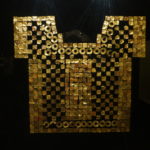
Tribes – like the founders of Caral nearly 5000 years ago, and successors like the Moche, Lambayeque, Wari and Chimu cultures up to 800 years ago – left behind striking evidence of their sophistication. Each produced pyramids, roads, intricate social structures, scientific and spiritual knowledge, including elaborate water irrigation systems, as well as magnificent art in ceramic and metals – all before the Incas from the south subdued them and then, in turn, the Spaniards.
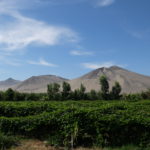
These cultures flourished in the midst of desert, as Lima still does today, because of rivers that begin in the Andes to the east and irrigate valleys as they run to the Pacific. It’s likely that these people followed those rivers down to the coast from the highlands where they first arose.
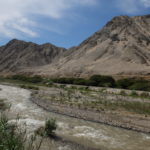
Traces even go back another 5000 years to the stone age with found artifacts like stone tools and weapons used by hunter-gatherers. Until just a few decades ago, no archeological records here older than 2500 years recorded agrarian societies sophisticated enough to construct large buildings and work at a high level in clay and metals.
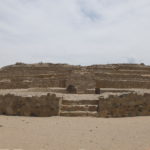
The discovery of the pyramid complex at Caral in the 1990s re-wrote the history books, not just for Peruvians, but globally. Discovered at Caral was a lost society whose achievements rivalled those of Mesapotamia and Eqypt, as well as early Indian and Chinese civilizations.
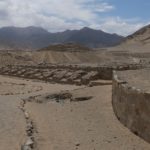
Though surrounded by desert, Caral stands in the startlingly verdant valley of Rio Supe, a few hundred kilometers north of Lima, where now avocados, cane and fruits grow. The Sacred City of Caral was the apparent capital for thousands of people spread along 20 kilometers and comprising nearly two dozen smaller villages. The central complex was enormous, with six pyramids of varying sizes over 60 hectares, for the spiritual, administrative and cultural leadership of the community. A massive open plaza encircled by these pyramids was the commercial center, with shops of various sorts to serve the community’s basic needs. Artifacts from this plaza indicate there were metal-working shops, textile shops, pot makers and so on.
After a few thousand years, probably because of changing climate, the people of Caral left, burying their pyramids in sand, in effect turning their clay buildings back into hills. But the architectural and religious structures they created formed the templates for subsequent civilizations across the valleys of northern Peru. Each of the pyramids at Caral had been built up over time, as the community and its needs grew, or perhaps with the rise and ambitions of new leadership. The largest of these goes up to nine or more tiers, nearly 30 meters high overall, each layer built by extending the original base outward, brick by brick, and adding the new brick layer atop. In the midst of archeological excavations, you can sometimes see where the old part and the new connected. At many of them, especially the largest, central one, two elements are especially interesting. The first is a circular area about 20 meters across, thrusting out from the base. This served for certain ritualistic ceremonies ensuring good weather for crops or avoiding the displeasure of the gods. At the pyramid’s top, you find the remains of some rooms, a kind of inner sanctum or monastery for the priestly class.

Though the people of Caral seemed to just disappear, their cultural heirs thrived with different tribes occupying similar river valleys of the desert up and down the coast of Peru. Some grew more extensive than others, notably the Moche or Mochica people from about 100 BC to around 800AD. This was the tribe around modern Lima. The Waris and Lambayeques followed, until most of these tribes were overcome and subsumed into the Chimu society from 1000 until 1470.
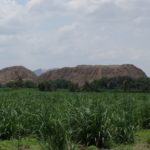
We know a lot more about those successors of Caral from the fuller record of artifacts that survives, including ceramics, gold pieces, other metal items and even some textiles – much of which has come from their ancient tombs – and from within the tiered pyramids that these cultures also built. Other evidence has been lost in the sands of time, as the clay bricks – originally contributed and inscribed by the different social groups – reverted to mud from erosion. The larger Moche pyramids at Sipan now look exactly like the hillsides they were meant to mimic.

So much else about these worlds has been lost due to extensive theft and plunder, particularly in the 30 chaotic years of the country from the 60s to the mid-90s, when the country was not organized enough to protect what remained. Savvy or opportunistic collectors swept up thousands and thousands of pieces. Some of these collectors fortunately opened their collections to the public and archeologists. The vast Larco Museum in Lima contains 45000 items that the Larco family collected. The smaller collection by Hans Heinrich Bruning in Lambayeque, near Chiclayo, might have ended up in Germany, but Bruning felt obliged to establish his museum back in Peru. In these collections, you can see sophisticated representations of animals and humans – at times strikingly realistic, at times symbolic – along with arresting depictions of everyday life and ritual practices akin to those of the Greeks.

The distinctive ceramic styles have largely been the distinguishing feature of the tribes for archeologists. The Chimu ceramics are monochrome, for example; the Moche, figurative, extremely realistic and detailed.
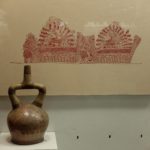
Every piece adds to the story of how these advanced cultures lived – from their food sources to their daily routines of irrigating, planting and harvesting to their essential beliefs and hierarchical structures.
And we learn further secrets from the more imposing clay of those tiered pyramids that remain – admiring the carved bas-reliefs on passageways and external walls as well as the ceramic and metal artwork that were uncovered from burial niches accommodating the notable and powerful. The rites and manner of their burial assured them a passage to the afterlife, and gave to their society some control over the mysteries of nature.
Now, emerging from their lost worlds, these people and their cultures have achieved a different kind of immortality, one that tells of their rituals of death, rites of sacrifice and the gods they prayed to.

Two of the greatest Moche pyramid temples, or huacas, are the Temples of the Sun and Moon (as they were named by the Incas). The Huaca del Sol was, until recently, open to thieves and the young at play. And it is sufficiently worn from the attack of winds and rain that it too looks more like a natural mountain than a building.

The Huaca de la Luna, fortunately now excavated in part by archeologists, was especially important to the Moche. On passageways through the structure used by spiritual and secular leaders, we see vivid images of two principal deities. One is the wrinkled man of the mountain, bringer of rain and a link to the heavens. The other is the Decapitator.
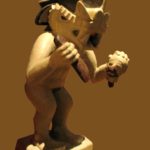
The Decapitator is a ferocious anthropomorphic figure who holds, in some representations, a lunar shaped knife in one hand and a lopped head in the other. He embodies the point of the sacrifices that attended important ceremonies. Somewhat dancing like his counterpart the Hindu Shiva, his role as destroyer also assures the regeneration of life through the sacrifice, as the harvest yields to the next growth.
His duality also reflects a dualistic world-view in these cultures, attentive to the oppositions of life and death, sun and moon, male and female. Many objects found by archeologists show two heads, as two beings or two sides of human life. Many of the precious adornments are cast half in gold and half in silver, sun and moon conjoined.


Within the Huaca de la Luna, we can view the platforms on which priests led the ritual sacrifices and ceremonies akin to an important depiction on one ceramic pot.

Even more astonishing to us is the grand courtyard, which had clearly been used for rituals like the one on the ceramic painting. The courtyard is decorated on one side where the priestly platform was located, and then lined on two other sides by running motiifs in bas-relief that rise 7 tiers up, each level taller than a person.
On the bottom tier, a few soldiers lead a long file of naked captured men tethered to each other. Above them come a series of hand-holding dancers, topped by other tiers with two-headed snakes, priests and stylized creatures, all celebrating the events.
This magnificent courtyard dazzles in both the grandeur of its accomplishment and the vivid reliefs. But this was no singular effort: a similar set of tiers reoccurs, in much worse condition now, at El Brujo.
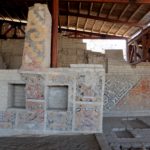
The Moche pyramid called El Brujo, between Trujilllo and Chiclayo to the north, has many other interesting and colorful reliefs as well, especially at the plaza surrounding a small shrine where the priests led ceremonies.
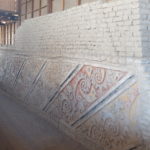
These reliefs represent gods like the important mountain god and creatures like octopus and catfish. This temple was, reportedly, the gathering place for shamans or, in Spanish, brujos, witches. With rituals nicely documented by ceramic paintings, these shamans practiced the black magic to appeal to the gods or cure medical problems, using an array of medicinal plants and liquids.
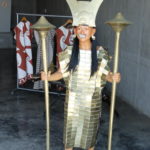
Here is where the story of death and the afterlife begins to come alive to visitors and archeologists – with the Lady of Cao.
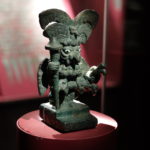
The Lady’s tomb was unearthed from a niche at the El Brujo temple. Though she died young in the 4th or 5th century, she seemed to be quite powerful as a priestess and shaman. The richness of her burial (18 layers of adornment in gold, jewels, precious shells and more) suggested a much higher role for women in the society than had been thought. The pots and other items buried with her – as well as the man sacrificed to accompany her – clearly demonstrated Moche burial practices and its view of death. She now lies nearby, in the El Brujo museum, together with many of her things, for all to see.
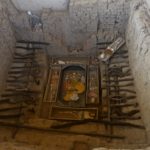
Even more important were the finds at Sipan in niches within earlier bricked layers of the pyramid there, as at Brujo. By now, 17 graves have been revealed, representing the three higher classes, those worthy of prestigious burials in the pyramids – the leadership lords, the priests who conducted the religious ceremonies, and the warriors who defended the tribe.
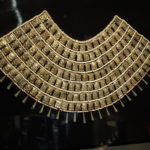
Three especially notable finds delivered rich artwork and information: former Moche leaders known as the Lord of Sipan, the Old Lord of Sipan and the Noble Priest-Warrior. These big three were buried like the Lady of Cao, adorned with gorgeous jewelry of gold and silver, bracelets and ornaments of tiny shells, added at burial in layers after layer on their bodies. The treasure trove was so great that it led to the building of a dazzling museum to show them off, the Tumbes Reales de Sipan, the Royal Tombs of Sipan in Lambayeque near Chiclayo.
In their new resting places, these honored dead – and their accoutrements – now speak eloquently to us again of life and death, the two aspects of the Decapitator.

Rituals of life – The pyramids of the Moche as well as those of Caral mainly served ceremonial functions including the housing and preparatory areas for the priests and the lords. These ceremonies centered on the agricultural needs of the people, the timing of planting and harvesting, the cycles of the sun and moon, and most especially in a land of deserts, the invocation of rain. These connected the domain of the living with that of the heavens.
Ceremonies could proceed for long periods of time, sustained by energizing substances like chicha (processed coca leaf), which is still a mainstay in South America. Or by hallucinogenics. Ritual sacrifices of animals like llamas or, notably, human ones, were an important part of the ceremony. The sacrificed people might have been captured members of other tribes, as the grand plaza reliefs suggest, or drawn from the population. Either way, doped up or just assured of a grand afterlife, they might not have been unwilling to give up life for the community.
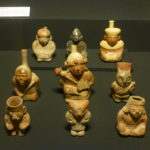
Rituals of death – The upper tier of society, as represented by those unbricked at Sipan, enjoyed splendid send-off ceremonies to assure appropriate respect and swift passage to the future. The body was mummified and set in various ways into niches of the brick pyramids. On their journey, they took with them the ceremonial items they wore in life, presumably so those they met in the afterlife could recognize them and they could continue to practice their skills.
They did not pass unprepared or unattended either. The remainder of the tomb was packed with bowls and pots for use in the passage to the afterlife, some of which look like miniature guards for the tomb. And then there were the others sacrificed and buried with them – some women, llamas and male guards. These people also appear to have gone voluntarily, so they could perhaps accompany their noble companion on the journey into the next realm. It seems that, afterwards, the living aimed to affirm their link to this third domain, the afterlife, by entering the tombs at times and somehow join in the journey taken already by the dead.
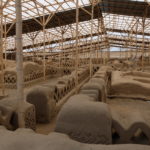
Though it appears its beliefs were similar, the Chimu people of a thousand years ago, with their more figurative monochromatic ceramics, may have stopped building these pyramids – or perhaps those are still lost in the earthen mounds scattered all over the Peruvian coastal desert. But the Chimu left a different record of their own advanced society, the vast complex of palaces at Chan Chan, the capital city of the Chimu close to the sea near Trujillo.
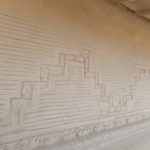
Though tombs and artifacts were found here, the decorations that have survived are not as rich in detail as at the earlier pyramids. You can still see some walls carved into geometric shapes, or repetitive clay decorations representing the oceans and the ife that sustained them – fish, pelicans, and so on. Instead what impresses here is the vast extent of the remaining complex, sprawling over six square kilometers out of some 20 km2 for the whole city.
Chan Chan dates from 900 to 1470, when the Incas swept up from the south and subsumed the Chimu and other tribes into their realm, only to be devastated by the Spaniards in the early 1500s, who plundered and destroyed most of Chan Chan.
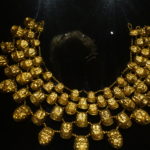
We could readily romanticize the history of the 4000 years we peeked into during our visit to the Peruvian coast, and why these cultures disappeared, along with their artistry, organizational ability, and powerful religious beliefs. Natural causes like drought, as well as the familiar story of the conquest, death and birth of societies – these have been the primary reasons their worlds were lost. The Spaniards were one more violent rupture.
Lost, yet quite recently found, regenerated in a way by what archeologists have discovered, adding much to the record of early human art and achievement. Lost, and found again, as visitors like us explore the sites where those ancient peoples founded their centers, and those superb museum collections of artifacts left behind. Now we can admire those who crafted their wondrous ceramics and jewelry, those who piled brick upon brick, tier upon tier, to raise their holy pyramids.
And we can gain lessons about our own potential for greatness and our likelihood for rise and fall – teachings from those who willingly or unwillingly made the passage from the world of the living to the lost worlds of the dead.
(Also, for more pictures from Peru, CLICK HERE to view the slideshow at the end of the itinerary page.)


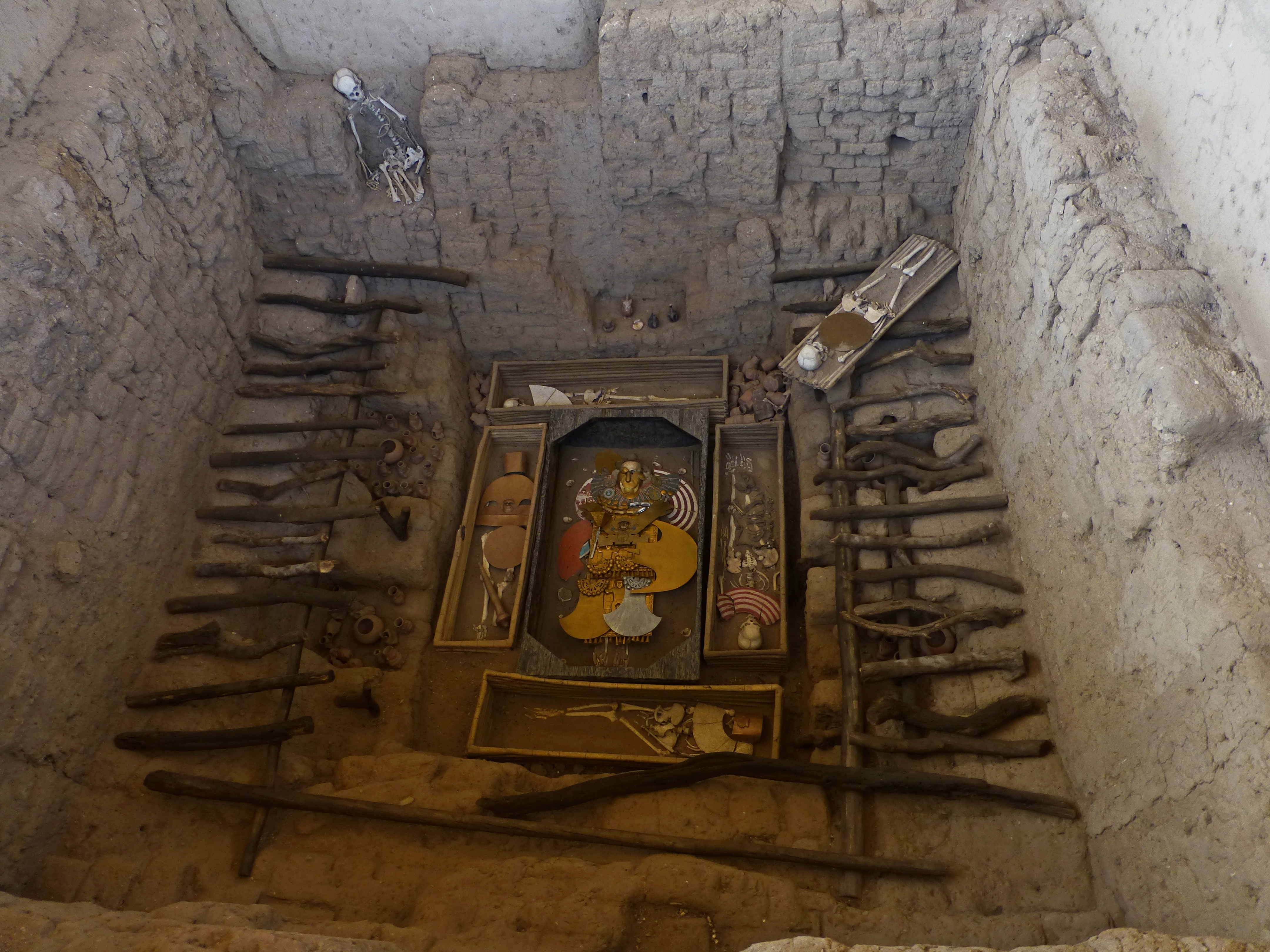
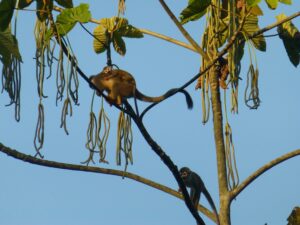
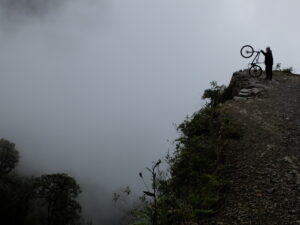
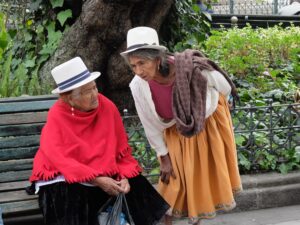
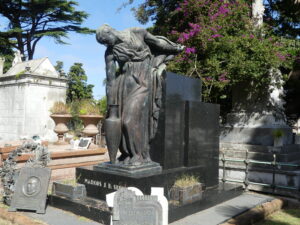
Very interesting. Loved it.
Thanks for the appreciative comment!